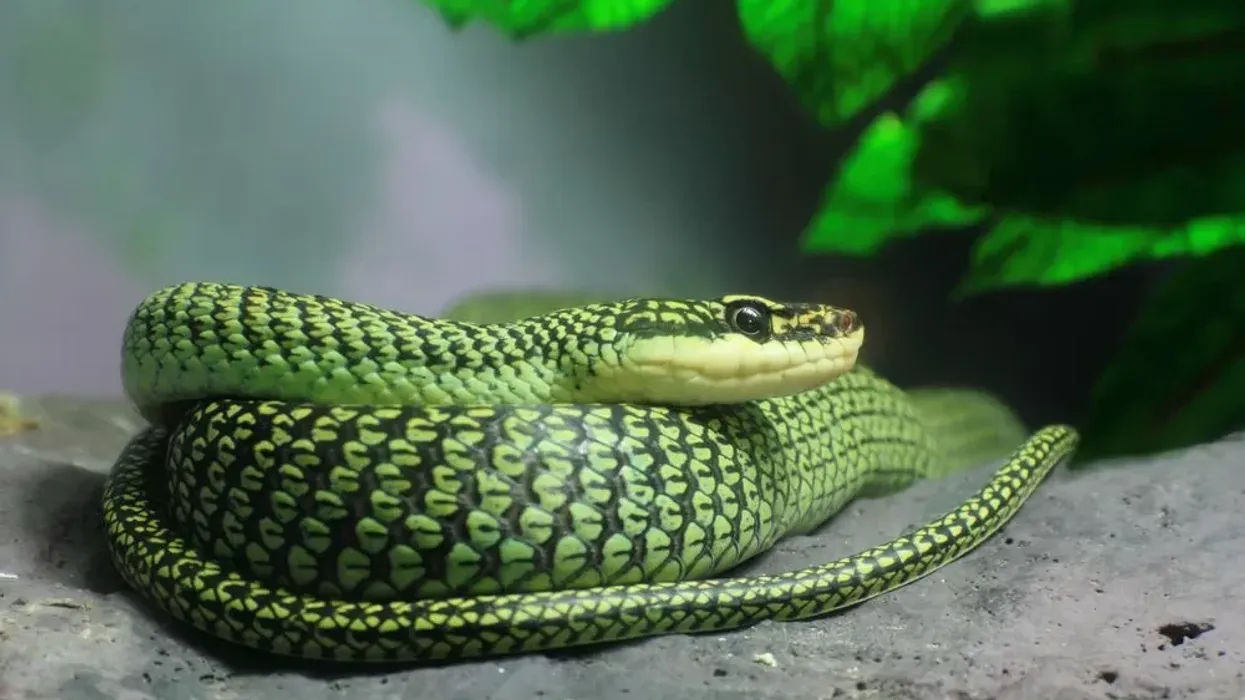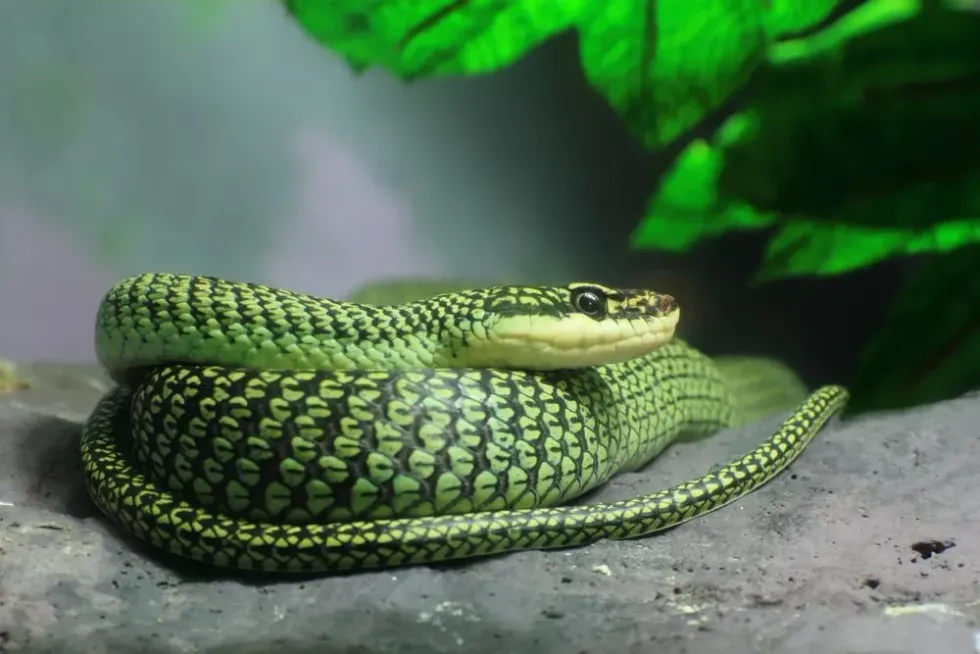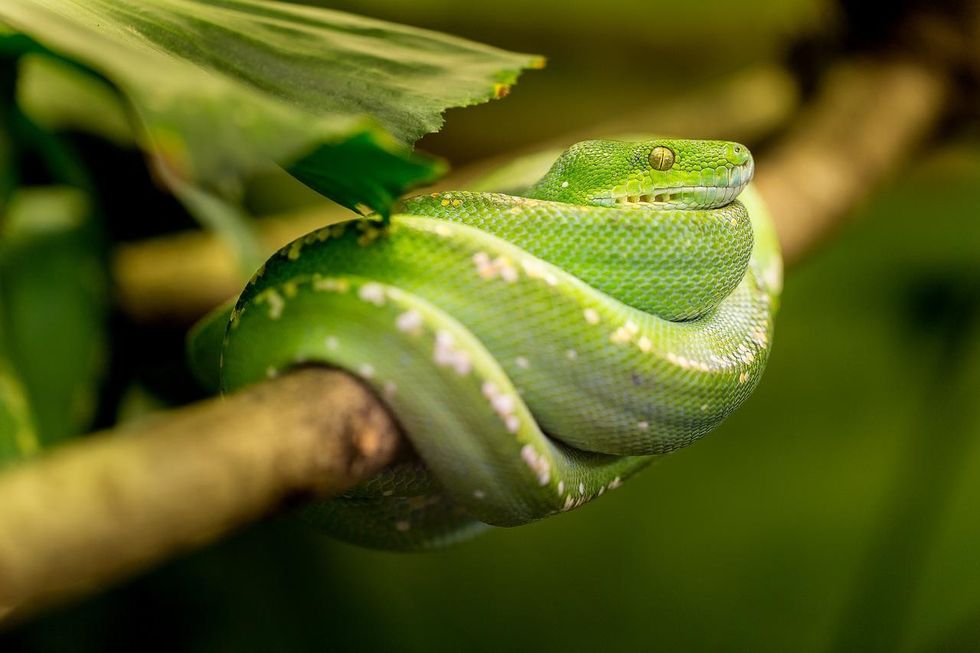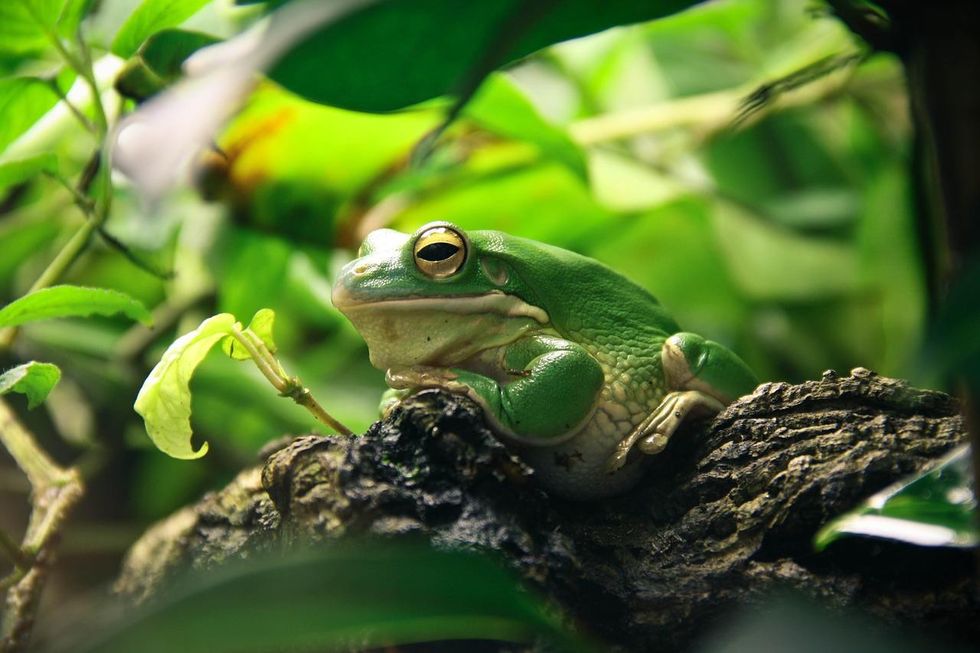The golden tree snake, Chrysopelea ornata, is a part of the largest family of snakes Colubridae found both in the south and southeast Asia. The golden tree snakes have various different names in English like gliding snake, ornate flying snake, golden flying snake, gold and black tree snake, and flying tree snake.
The Thai name for this species is งูเขียวดอกหมาก (Ngoo kee-ow dork maak).
And in India, this species is known as Kaalnagini. The flying snakes also have various regional names from place to place.
Like the paradise tree snake, one of the most famous flying snakes in the world, the golden tree snake can also glide through the air. Differentiated by their scientific name, the ornate flying snake, Chrysopelea ornata, is known for its capability of gliding from trees to trees.
The species Chrysopelea contains all the flying snakes or gliding snakes. The striking looks of the golden tree snakes give it much of its recognition in the outside world away from their natural forests.
Mostly found in India, Sri Lanka, Thailand, and most of SE Asia, the flying snakes are mildly venomous and do not affect the physiology of humans.
The venom of the snake species is not dangerous at all to humans. The snake is a rear-fanged snake, like all the flying snakes in the world.
The Golden tree snakes or Chrysopelea ornata are mostly found in the Eastern and Western ghats of India. They rely on vision and stealth to grab their prey and are very proficient at it.
The flying snakes are also diurnal and arboreal. The flying snake is always alert and does not hesitate to bite if mishandled, although the venom won't affect humans much. They are also very nervous in nature.
These flying snakes are usually non-offensive and flee their enemies with their perfect glide across trees. Any height is manageable for the golden flying snake.
Same as the Chrysopelea ornata, the Chrysopelea taprobanicais a Sri Lankan flying snake also found in the southeastern ghats of India, but it's very rare in the country. It is also known for its ability to glide like all other flying snakes and distributed in all countries mentioned above.
A few other snakes similar to the golden flying snake are the coachwhip and the Western Diamondback Rattlesnake. Read some fun facts about these reptiles once you're done with this article!
Golden Tree Snake Interesting Facts
What type of animal is a Golden Tree Snake?
The Golden Tree Snake is a type of snake found in SE Asian countries.
What class of animal does a Golden Tree Snake belong to?
The golden tree snakes, the scientific name Chrysopelea ornata, fall under the class of Reptilia in the family of Colubridae.
How many Golden Tree Snakes are there in the world?
The population of the flying snake is unknown at the moment.
Where does a Golden Tree Snake live?
Golden tree snake species are found in North Bengal in India, Bangladesh, Myanmar, Thailand, Sri Lanka, Western Malaysia, Laos, China, Indonesia, Vietnam, Cambodia, and the Philippines. Even in the Andaman Islands in the Indian ocean, these snakes are abundantly found.
These species have adapted well to human habits and are commonly found in rainforests, dry deciduous forests, plantations, and urban areas.
What is a Golden Tree Snake's habitat?
This species lives a solitary and arboreal life. Their ability to glide makes it easier for them to glide from tree to tree. The golden flying snake can be found in various habitats like secondary forests, plantations, agricultural areas, and rural gardens.
They can also climb significant heights in trees and big walls of buildings. They are also seen climbing coconut palms using their scales to grip the surfaces of the trees and stones. Large trees in thick forests are the natural homes for this species.
Who do Golden Tree Snakes live with?
The golden tree snakes are usually shy and stay alone. They love being in solidarity and also prey alone.
How long does a Golden Tree Snake live?
The lifespan of a golden tree snake ranges from 4-12 years.
How do they reproduce?
The golden tree snakes do not mate in captivity. So, the breeding system of the ornata is unknown to us. They lay eggs in general. Around 6-12 eggs are laid in May and June which are of elongated shape.
June is their mating season and the snakes pick high tree holes and crevices for roosting. This is where they lay their eggs. The eggs hatch in June. The young measure around 4.5-6 in, in general. The smallest gravid female recorded was 3 ft 7 in long.
What is their conservation status?
The conservation status of the golden tree snake is kept as Least Concern. There are plenty of these mildly venomous snakes in the world, especially the SE Asian countries. They are, although, killed a lot in urban areas due to fear. They are also popular in the pet trade and die during stressful journeys.
Golden Tree Snake Fun Facts
What does a Golden Tree Snake look like?
These snakes are usually green with black cross-hatching and yellow/gold-colored accents. Although the name says golden, In India and Sri Lanka, it is more of a greenish-yellow color.
The snake has a flattened head, a constricted neck, large eyes with round pupils, and a blunt nose. The underside of the snake is greenish.
It also has a rear fang which means the prey cannot escape once the snake grabs them. It also has a lateral, sharp, and pronounced keeled condition on the ventral scales along with normal, vertebral row scales.
The colors vary geographically from place to place from yellow, green to gold, and red. As discussed, in India and Sri Lanka, the snake is greenish-yellow or pale green. Each scale in the snake has a black spot. They also have dark crossbars at intervals.
Some reddish or orange vertebral spots may be present. The head is black with yellow crossbars. The southeast Asian version lacks the reddish vertebral spots and the black crossbars are less prominent.

How cute are they?
The snakes are beautiful with vibrant colors on their body.
How do they communicate?
Pheromones are used by snakes, in general, to communicate with each other.
How big is a Golden Tree Snake?
The usual length of an adult golden tree snake ranges from 4.5-50.4 in (11.5-130 cm). The young hatchlings measure around 4.5-6 in, in general, after birth.
How fast can a Golden Tree Snake move?
The golden tree snake can move very fast when threatened and can glide from one tree to another very speedily. They are quick movers and are pretty fast in their travel. Although the actual speed of the snake is not known, they are presumed to be pretty quick.
How much does a Golden Tree Snake weigh?
The weight of a golden tree snake ranges from 1-2.2 lb (450-1 kg). The two-pound snake is the largest in this species and is quite lightweight.
What are their male and female names of the species?
The species, Chrysopelea ornata, does not have different names for the male and female sexes. They are collectively known as Golden Tree Snakes.
What would you call a baby Golden Tree Snake?
A baby golden tree snake is usually known by the name of juveniles. There is no other name given to this breed of snakes.
What do they eat?
The golden tree snakes are active during the day and usually feed on frogs, skinks, geckos, lizards, bird eggs, reptile eggs, small mammals, stranded tadpoles, and fish. They jump from tree to tree to find their prey and scavenge both ground and trees for food.
Are they poisonous?
They are mildly venomous and are not harmful to human beings. Their venom is not strong enough and they even feed on food by strangling their prey.
Would they make a good pet?
The snake's beautiful and striking scales and capability to glide between trees makes them a good candidate for captivity. Although, they are better suited to their natural habitat and should not be kept in captivity.
They thrive in their habitat of trees in the forests and goes through breeding only in the wild. In captivity, they are known not to indulge in mating.
Some traders sell these snakes to circuses and snake charmers, which are bad for the species.
Did you know...
Golden tree-nosed snake card and golden tree snake card are very famously used as card designs in Thailand and the Philippines.
The ornata is a part of the genus Chrysopelea, which is a group for all flying snakes. Flying snakes are found in abundance in Thailand, India, Sri Lanka, and many SE Asian countries.
Green tree snakes do not have strong jaws and cannot hurt a person. It is harmless in this regard and is poisonless.
Tree snakes straighten their body before a glide, and that is how they create lift. They use the speed of free fall and contortions of their bodies to catch the air and generate lift.
Do they bite?
Yes, the golden tree snakes bite if mishandled. These are a nervous, fast-moving breed and often flee before getting caught. If handled, the golden tree snake bite is strong, but its venom is mild and is not dangerous to humans.
Are they slimy?
Snakes are often presumed to be slimy because of their shiny appearance. Snake skins are very smooth and soft, like leather, and are definitely not slimy.
Here at Kidadl, we have carefully created lots of interesting family-friendly animal facts for everyone to discover! Learn more about some other reptiles including Boa and Black Mamba.
You can even occupy yourself at home by drawing one on our golden tree snake coloring pages.










